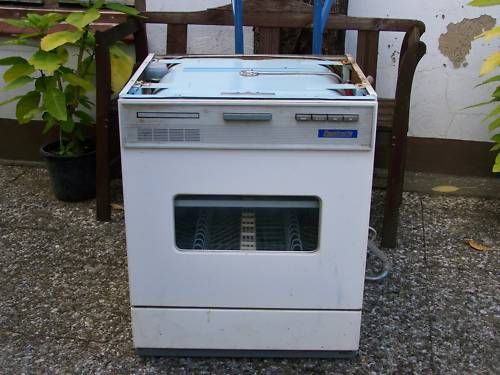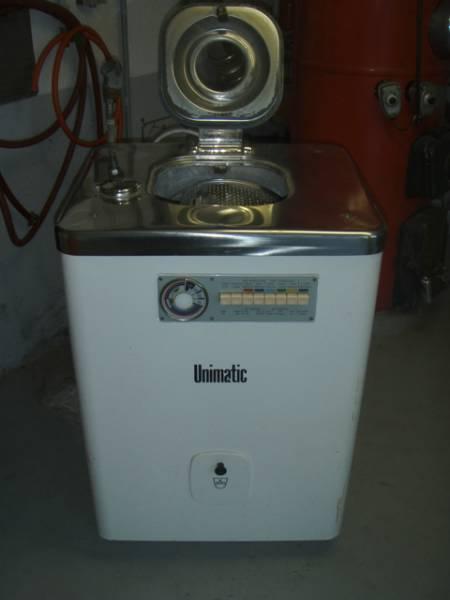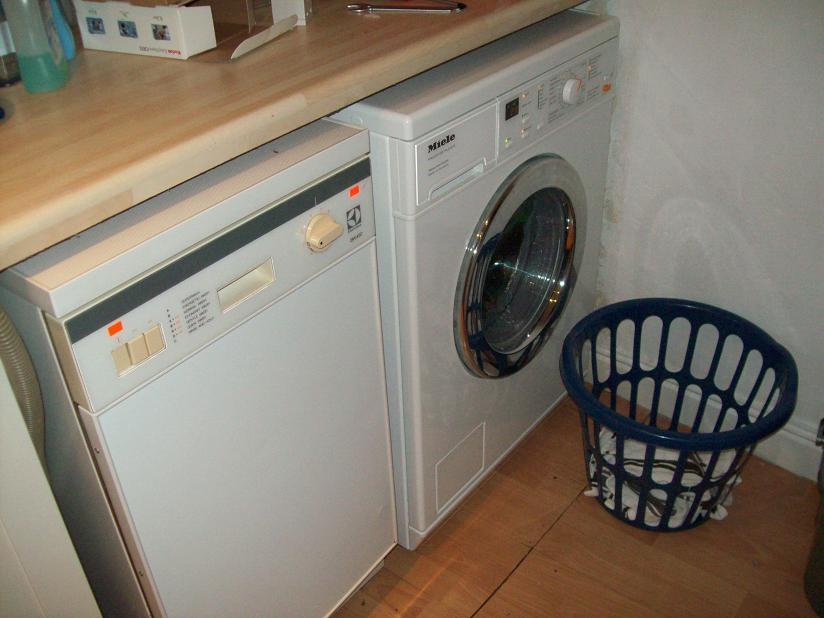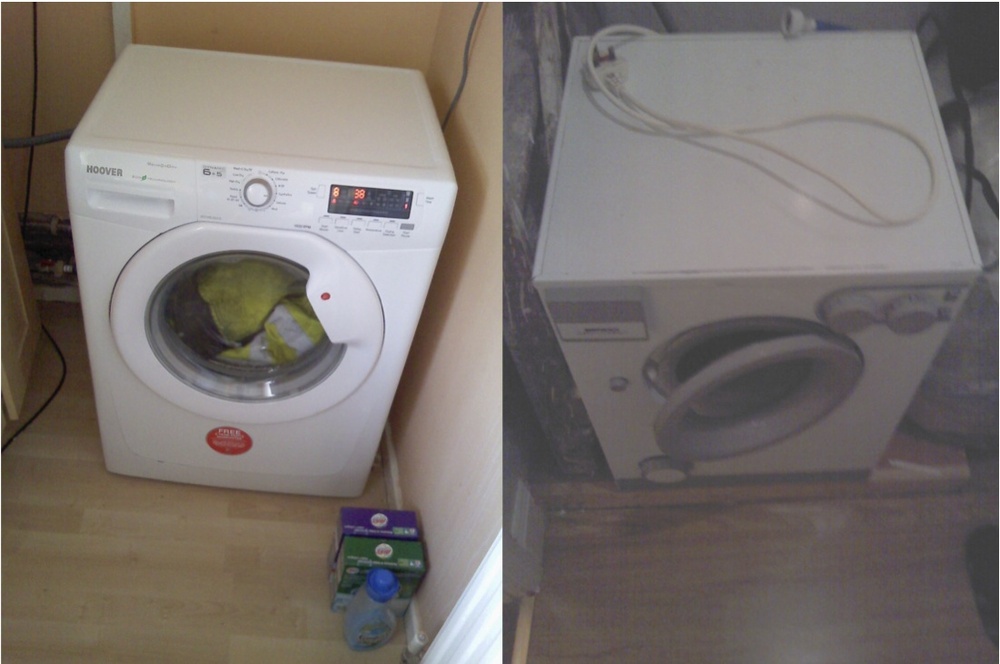|
Thread Number: 31029
Why UK machines usually different from US |
[Down to Last] |

|
| Post# 468233 , Reply# 1 10/9/2010 at 20:12 (4,939 days old) by ronhic (Canberra, Australia) | ||
Welll.......
....it's a bit of everything from my experience living in the UK.
The majority of UK homes are smaller, and dare I say often much older, than their Nth American equivalents. It is not common to have a cellar or separate laundry room, particularly in homes built before say, 1980 (and yes, I did just pluck a date....correct me if I'm wrong please). As a result, most machines needed to be usable as an additional work surface in the days before fully integrated kitchens...Twin tubs, small top-loaders, single tub wringers (where the wringers folded into the tub for storage) and front loaders could all be had with work surfaces. They also needed to be able to be moved to the kitchen sink for use. Moving into the latter decades of the last century, fitted kitchens became more common which enabled a more integrated machine. As people pulled out old cabinets and put in new kitchens, they made allowances to have a dedicated washing machine space near the sink - this gave access to the hot/cold water and waste pipes. It also meant not having to wheel machines to the sink and helped free up space in the kitchen. Front loaders are the only machines that are suitable for building under a benchtop....so after many years of running different types of machine, UK manufacturers (and now retailers) defaulted to building (though no longer built in the UK) and selling front load machines with very rare exceptions to this. As to the size of machines, this seems to have almost sorted itself out. The vast majority of front load machines sold in the UK and Europe over the past 40years have restricted themselves to a fraction under 60cm/2 feet. It is a common and convienient size that works well with washing machines, dryers (also often in a kitchen) and dishwashers with most kitchen cupboards and drawer units being available in 30cm, 45cm and 60cm sizes (1, 1 1/2 and 2 feet). Door size is also limited to overall machine size. You can put a bigger door in a 27" machine than you can a 24" machine and still retain the same structural rigidity....also, the drums of Nth American machines are larger in diameter and therefore volume. Hope this all makes sense. UK and European guys, please feel free to correct me. On another note though, Australia has also accepted the UK/European standard for kitchens....but most Australian homes have a laundry room. However, as people renovate, there is a move to a smoother, more integrated look in the laundry...so often appliances are no being built under the counter.....which is, along with water restrictions and a call to be more enviro friendly, causing a dramatic increase in front loader purchase. | ||
Post# 468293 , Reply# 4 10/10/2010 at 04:54 (4,939 days old) by foraloysius  (Leeuwarden, Friesland, the Netherlands) (Leeuwarden, Friesland, the Netherlands) |
||
There is more to it...
In the sixties Miele, Bosch and Constructa and perhaps others had appliances that were wider than the standard 60cm. My mother had a Bosch washer that was 67cm wide. The older Miele G45 dishwasher I had also was 67cm as is this Constructa dishwasher. Manufacturers were free to give their appliances the size they wanted. But late 60's or early 70's the European standard in kitchens was introduced. The standard size for appliances became 85cm high, 60cm wide and max. 60cm deep. This standard was introduced to make it easier to fit in whatever brand of appliances into a standard kitchen. Since then European frontloaders almost all have the same size. This especially applies to the UK where it seems more a custom to have the washer in the kitchen.
The size of the machines might be smaller than an American washer, but at that time a European washer still would hold 5kg of laundry which is the same as 11lbs. I think that would be the amount of laundry a Unimatic can wash. 
| ||
| Post# 468294 , Reply# 5 10/10/2010 at 05:03 (4,939 days old) by aegokocarat (United Kingdom) | ||
|
and over here our washing machines have 3 compartment drawers well some do coz aeg go themselves 4 compartent drawers anyway on ours it is prewash mainwash and softener on yours it detergent bleach softener and liqudid detergent (i think) | ||
Post# 468295 , Reply# 6 10/10/2010 at 05:05 (4,939 days old) by foraloysius  (Leeuwarden, Friesland, the Netherlands) (Leeuwarden, Friesland, the Netherlands) |
||

In other countries than the UK European toploaders are more popular. They are even a tad smaller than the frontloaders but on average hold the same amount of laundry. Especially in France these toploaders are very popular, more so than the frontloaders. These toploaders are of the H-axis type. The first H-axis toploader was made in Switzerland by V-Zug. Here is a picture of it.

| ||
Post# 468296 , Reply# 7 10/10/2010 at 05:09 (4,939 days old) by foraloysius  (Leeuwarden, Friesland, the Netherlands) (Leeuwarden, Friesland, the Netherlands) |
||
 | ||
Post# 468309 , Reply# 8 10/10/2010 at 08:24 (4,939 days old) by Vacbear58  (Sutton In Ashfield, East Midlands, UK) (Sutton In Ashfield, East Midlands, UK) |
||
Chris is right on target 
with his description, I could hardly have put it better myself. Just a couple of things to add: In the US there was a long tradition of wringer washers with centre agitators, in the UK there was no such legacy. I believe the first auto was a Bendix (so a tumble machine) but I presume that a top loader was more acceptable to the US market given the history.
True there were similar washers in the UK pre WW2, but not common, and the first "popular" machine (for reasons already discussed) was the Hoover 0307, not a centre agitator machine. The first autos here (in any number) were also tumble machines (Bendix & English Electric) and it was not until 1963 when there began to be some variety, not only centre agitator but also H axis. But as Chris explains the ability to put the machine under a counter top became crucial. Louis, I love the Constructa dishwasher! As you say, the machines were all variety of sizes, although interestingly all the top loaders I could find (including a Frigidaire "thumper")were all 60cm or slightly less. But interesting also to see how the European standard brought us our Matchbox Hoovers and the Hotpoint & Servis machines which were actually even smaller than that, but still washed 9lb. And of course hardly anyone except me has their laundry equipment in the bathroom in the UK Al | ||
| Post# 468388 , Reply# 9 10/10/2010 at 15:39 (4,939 days old) by ronhic (Canberra, Australia) | ||
And of course hardly anyone except me has their laundry equi
Al,
Would that have something to do with the Electrical Safety Standards and no 240V outlets (or even wall light switches) in bathrooms? I know that in flats here, there is a pretty reasonable split between those that actually have a small laundry and those that have plumbing in the bathroom, but then we can have a 240V outlet too.... | ||
Post# 468395 , Reply# 10 10/10/2010 at 17:02 (4,938 days old) by Vacbear58  (Sutton In Ashfield, East Midlands, UK) (Sutton In Ashfield, East Midlands, UK) |
||
Electrical standards
Outlets are (or were) permitted as long as they are not accessible from the bath, in my case they are well protected just above the stacked drier.
I think it is more a case that UK bathrooms are just as small as UK kitchens. Having had the washer and drier in the bathroom in my last home (apartment) when I was viewing this house as soon as I saw the space in the bathroom the measuring tape was out straight away and I was very pleased to see there was enough space to accommodate them in a similar manner. The space would otherwise be wasted and, in my small kitchen, it would have been difficult to accommodate a separate washer and drier as well as dishwasher etc. The only form of outlet allowed for general access in UK bathrooms are two pin sockets for shavers or in my case a toothbrush, fused at 1 amp, they frequently have dual voltage. Al | ||
| Post# 468407 , Reply# 11 10/10/2010 at 18:20 (4,938 days old) by ronhic (Canberra, Australia) | ||
We were very lucky with our flat.... | ||
| Post# 468715 , Reply# 15 10/12/2010 at 04:30 (4,937 days old) by AquaCycle (West Yorkshire, UK) | ||

I think all the other guys on here got it spot on. In the UK, houses are much smaller - especially houses built around the late 1800's. Most houses were built as 2 up - 2 down houses in rows for mill workers. Although a lot of these did have cellar's, they were mostly coal cellars used for storing coal for ranges and heating. It's also important to note that most of these houses were not built with in-door plumbing and shared toilets were built at the end of the street or behind the row. The next big wave of houses came in the post-war 1940's when local authority council housing started appearing, but obviously at the time washing machines not widely available, especially to families on low income, who would be living in this type of house. Most homes in the UK have washing machines in the kitchen. so it is necessary to save worktop space, and have appliances that fit under the counter top. Newer houses often have utility rooms, or plumbing in the garage, but this is a relatively new thing. I have to say, in my tiny 2 bed terrace house, I cannot imagine having a top-loading machine. It would literally take up half my kitchen.
| ||
Post# 468795 , Reply# 16 10/12/2010 at 14:38 (4,937 days old) by foraloysius  (Leeuwarden, Friesland, the Netherlands) (Leeuwarden, Friesland, the Netherlands) |
||
Hydralique | ||
Post# 469016 , Reply# 17 10/13/2010 at 08:21 (4,936 days old) by mrboilwash  (Munich,Germany) (Munich,Germany) |
||

Space might have been an important reason too, but I believe the main reasons for FL machines being so dominant in Europe was because of much higher energy costs here.
I could also imagine that their gentleness and thoroughness was an important factor. In Germany almost every house has a cellar and AFAIK we never ever had an automatic agitator washer on the market. There have been wringer washers and twin tubs with agitators but no automatics. I think our earliest Automatics had no advantage in water efficiency and they often spun much worse than any US Toploader. | ||
| Post# 469097 , Reply# 19 10/13/2010 at 21:19 (4,935 days old) by jerrod6 (Southeastern Pennsylvania) | ||
|
2 up 2 down AquaCycle: Pardon me, but can you describe what a 2 up 2 down house is? | ||
| Post# 469098 , Reply# 20 10/13/2010 at 21:35 (4,935 days old) by ronhic (Canberra, Australia) | ||
what a 2 up 2 down house is?
Simple...
2 living spaces downstairs - Kitchen and 'Front Room' (living/lounge room) 2 bedrooms upstairs... Note that there are no bathroom references. A 'traditional' 2 up/2 down property would have had an outside toilet with bathing most likely to take place in the kitchen in a removable tub close to hot water and warmth.... | ||
| Post# 469262 , Reply# 21 10/14/2010 at 05:59 (4,935 days old) by AquaCycle (West Yorkshire, UK) | ||
 | ||
| Post# 469263 , Reply# 22 10/14/2010 at 06:14 (4,935 days old) by AquaCycle (West Yorkshire, UK) | ||
 | ||
| Post# 469264 , Reply# 23 10/14/2010 at 06:18 (4,935 days old) by AquaCycle (West Yorkshire, UK) | ||

and this one...
this is the type of house I live in now. I'd like to point out though, it is not of low quality, or poorly lit, or poorly ventilated anymore lol. But you should get what I mean. Even after modern refurbishments, it would be an incredibly tight squeeze to fit in an american-style toploading washing machine and matching dryer. This is how my washing machine and dishwasher are set up in my kitchen: CLICK HERE TO GO TO AquaCycle's LINK 
| ||
Post# 469341 , Reply# 26 10/14/2010 at 17:12 (4,934 days old) by Vacbear58  (Sutton In Ashfield, East Midlands, UK) (Sutton In Ashfield, East Midlands, UK) |
||
And I will echo it too
With the added proviso that a great deal of the housing stock built in the UK in the 20th century, at least pre-war, also had very small kitchens. When house hunting in the past I have been staggered to see kitchens not much more than 5ft wide - certainly not big enough for 60cm counters on either side, and often with two doors as well. Certainly not built for the wealth of modern appliances. It was only with changes in building regulations that houses began to have decent sized kitchens, especially public housing stock
| ||
| Post# 469441 , Reply# 27 10/15/2010 at 07:19 (4,934 days old) by AquaCycle (West Yorkshire, UK) | ||
solsburian..
I know just what you mean. Both sets of grandparents in my family were on automatics by the time I was born in 1990, but my great grandparents both still used Twin Tubs - my Great Grandma Parker (grandads mum) had a Hotpoint twinny, and my Nana (grandma's mum) had a Hoovermatic. My Nana was 96 when she died in 2000. She was still very mobile, but couldn't deal with lugging out the twin tub once a week to do her washing. In her early 90's my great aunt bought her an automatic, but she always swore blind that her old Hoovermatic cleaned everything way better than the Indesit that replaced it, but she appreciated it's ease of use.
| ||
| Post# 469704 , Reply# 29 10/16/2010 at 14:30 (4,933 days old) by AquaCycle (West Yorkshire, UK) | ||

In all honesty, dude, I think you were probably better off with the bendix lol. Not a fan of modern Hoover washers, I'm afraid, but hope you're getting the best out of it and enjoying it all the same :). I've got a Miele W562 Prestige Plus and a Hoover Electron dryer. Grandma still has her 1980 Hotpoint matching set :)
| ||
Post# 469862 , Reply# 32 10/17/2010 at 08:20 (4,932 days old) by foraloysius  (Leeuwarden, Friesland, the Netherlands) (Leeuwarden, Friesland, the Netherlands) |
||
 | ||
Post# 469864 , Reply# 33 10/17/2010 at 09:25 (4,932 days old) by mrboilwash  (Munich,Germany) (Munich,Germany) |
||
OMG now I`m getting excited, too !
Notice that dishwasher has 4 little seperate sprayarms for the bottom rack !
Have seen one of them in the trash when I was still a child but I didn`t know until now it was a Constructa. Did they also come without a window ? I don`t seem to remember it had one... This one and an old Bauknecht are the only German DWs I have ever seen with a plastic interior. | ||
Post# 470092 , Reply# 34 10/18/2010 at 12:47 (4,931 days old) by foraloysius  (Leeuwarden, Friesland, the Netherlands) (Leeuwarden, Friesland, the Netherlands) |
||

Actually there was a model without a window, at least Siemens sold the same machine without a window. It was a Siemens GS. According to the brochure I have (I must reinstall my scanner sometime) there was a model GS 12 (without water softener) and a model GS 13 (with water softener).
In the late seventies (early eighties?) Bosch and Siemens had a BOL dishwasher with a plastic interior (in the Dutch brochure the material was called Hostaleen PP). The Siemens model was the WG3800. I don't know what the equivalent Bosch model was but I know there was one, I once had a date with somebody who had a BOL Bosch dishwasher with plastic interior. | ||
Post# 470114 , Reply# 35 10/18/2010 at 14:01 (4,931 days old) by chestermikeuk  (Rainhill *Home of the RailwayTrials* Merseyside,UK) (Rainhill *Home of the RailwayTrials* Merseyside,UK) |
||
I once had a date with somebody who had a BOL Bosch dishwash
Louis you made me laugh after a heavy day with that line!! That could be straight out of a Victoria Wood Acorn Antiques sketch...LOL
Talking of British washing machines - my avatar pic is the first true all British Washing Machine - The Servis Model A produced 1929...about to undergo a spa & motor tuneup...only 50 of them ever produced and its thanks to the Spa of Neil (aka Fanny) that it was found in a local spares shop around the corner from the Servis HQ in Darlaston, West Midlands... | ||
| Post# 470118 , Reply# 36 10/18/2010 at 14:18 (4,931 days old) by AquaCycle (West Yorkshire, UK) | ||
Favorit... | ||
| Post# 470129 , Reply# 37 10/18/2010 at 15:17 (4,931 days old) by solsburian (SE Northumberland) | ||
|
Here are pics of our new Hoover WD and our old Bendix Compact. BTW After just over a week of owning the Hoover, it appears to have developed a fault! 
| ||
Post# 470276 , Reply# 38 10/19/2010 at 11:46 (4,930 days old) by foraloysius  (Leeuwarden, Friesland, the Netherlands) (Leeuwarden, Friesland, the Netherlands) |
||
Acorn Antiques | ||
| Post# 470296 , Reply# 39 10/19/2010 at 12:25 (4,930 days old) by vivalalavatrice () | ||
|
Oh Louis!!! That UNIMATIC!!! | ||
| Post# 470319 , Reply# 40 10/19/2010 at 13:39 (4,930 days old) by AquaCycle (West Yorkshire, UK) | ||
solsburian.. | ||
Post# 470322 , Reply# 41 10/19/2010 at 13:56 (4,930 days old) by foraloysius  (Leeuwarden, Friesland, the Netherlands) (Leeuwarden, Friesland, the Netherlands) |
||
Diomede
If you want to see such a Unimatic in real you should visit the V-Zug museum sometime in Zug, Switzerland. It's not very big, but there are some nice machines. I have been there some years ago and was allowed to make some pictures. The link goes to my photos.
BTW, it would be better to discuss the problems with that Hoover in a separate thread in the Deluxe Forum. CLICK HERE TO GO TO foraloysius's LINK | ||

 Comes to the Rescue!
Comes to the Rescue!